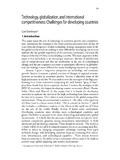Transcription of Australia's demographic challenges - Treasury
1 australia s demographic challenges australia s demographic challenges Commonwealth of australia 2004 ISBN 0 642 74230 8 This work is copyright. Apart from any use as permitted under the Copyright Act 1968, no part may be reproduced by any process without prior written permission from the Commonwealth available from the Department of Communications, Information Technology and the Arts. Requests and inquiries concerning reproduction and rights should be addressed to: The Commonwealth Copyright Administration Intellectual Property Branch Department of Communications, Information Technology and the Arts GPO Box 2154 CANBERRA ACT 2601 Or posted at: III | australia s demographic challenges Contents Introduction 1 Improving the capacity for work 3 Better incentives 7 Supporting more flexible work options 13 Conclusion 17 Appendix the economic implications of an ageing population 18 The Australian population is ageing 18 The policy challenge 23 So what are the choices?
2 25 1 | australia s demographic challenges Introduction The Australian Government s Intergenerational Report (IGR) projects that over the next 40 years, the proportion of the population aged over 65 years will almost double to around 25 per cent. At the same time, growth in the population of traditional workforce age 15 to 64 is expected to slow to almost zero. This will have a profound effect on the economy and, potentially, on our living standards. The recent stagnation of the Japanese economy has been at least partly driven by its rapidly ageing population, and provides a warning to australia to start preparing for these issues now. Over time, the ageing of our population will result in a greater demand for Age Pensions and health and aged care spending.
3 And the need to keep up with changing technology and community expectations of accessing the most advanced diagnostic tests and medical treatments is putting ever increasing demands on health spending. The IGR projects that these pressures will continue. The IGR puts together all of these major expenditure factors health, aged care, pensions and education and projects that spending by the Australian Government will exceed the amount it raises in taxes by around 5 per cent of GDP by 2041-42. To put this into perspective, the 2003-04 forecast is for a surplus of $ billion. A budget deficit of 5 per cent of GDP would mean that for 2003-04 the deficit would be around $40 billion. The Government s preferred solution to this challenge is to implement policies designed to grow the economy more quickly.
4 A larger economy will provide us with higher incomes, improved living standards and better enable us to meet the costs associated with our ageing population. Further detail on these issues is contained in the Appendix. The best way to achieve higher economic growth is via increases in labour force participation and productivity. australia has recently enjoyed very strong productivity growth. To maintain this performance into the future we will need to continue with reforms that free-up economic activity, enhance labour market flexibility, strengthen competition, and continue to develop a more innovative and dynamic society. The gains we can make from improving productivity growth are, over the longer term, virtually unlimited.
5 But that is not to say the task will be easy. It will also need to be accompanied by continuing sound fiscal policy and maintaining a low inflation economy. We also have considerable potential to improve our labour force participation rates. Participating in the workforce makes people wealthier during their lives, and also means that they have higher incomes in retirement. There is also evidence that those who participate are, in general, healthier than those who do not. Labour force participation rates are influenced by individual choices and respond to incentives and barriers. Amongst OECD countries, australia s total participation rate ranked twelfth in 2002, suggesting we have significant potential to improve participation both in the short and medium term (Chart 1).
6 For men aged 60 to 64, Australian participation rates ranked fourteenth. Equally, while women s participation has increased over the last 20 years, including for the mature aged, these increases were consistent with the trend across most other OECD countries, and australia remained in the middle of the OECD for this group. 2 | australia s demographic challenges 0 10 20 30 40 50 60 70 80 90 IcelandSwitzerlandNorwayDenmarkSwedenCan adaUnited KingdomUnited StatesNew ZealandNetherlandsFinlandAustraliaJapanP ortugalGermanyCzechAustriaSlovakFranceIr elandSpainKoreaLuxembourgPolandBelgiumGr eeceMexicoItalyHungaryTurkey Chart 1: OECD Total Participation Rates 2002 Significant improvements in participation are possible, and will benefit those who currently are unable to find employment.
7 The government has identified a number of opportunities to improve participation: improvements in the capacity for work, through better health and education better incentives for work improved flexibility in the workplace. Our recent record of economic reform means that by comparison with other countries, which have even larger problems, australia is among the countries best placed to deal with an ageing population. The most important thing is that we start to prepare for these changes now. In some cases this will not be easy. We must remember that many of the benefits enjoyed by Australians today are the outcomes of the sacrifices and investments of earlier generations. So too the prosperity of future generations depends upon the decisions we make today.
8 Equity and fairness across generations a key building block for increasing the prosperity of nations over time is particularly important in times of major demographic change, when the risks are higher. By making wise investments in infrastructure, services and programs, and maintaining prudent fiscal policies we can leave future generations with an ongoing legacy of freedom, social cohesion, opportunity and prosperity. This document sets out some of the most important issues we will need to think about over the next few years. 3 | australia s demographic challenges Improving the capacity for work A key aspect of improving participation will be to ensure that all those who wish to participate have the capacity to do so.
9 This will involve ensuring that our education system provides adequate and relevant training to equip our workers with the skills they require. In addition, our health system will need to focus both on preventing illness and injury and, where sickness and injury do occur, assisting Australians to return to health as soon as possible. Education and Skills the key to ensuring effective partici pation Over the last 40 years, australia has changed dramatically. We have become more educated and skilled, and we have become more flexible, adaptable and better able to use new skills and technologies. Further increasing our skills and educational attainment will be important in improving our productivity and labour force participation.
10 Higher skills and educational levels help in the creation of knowledge, ideas and technological innovation. As the world around us continues to change rapidly, especially with technological change, efficient and effective post-compulsory education and training systems will become more important. Current and future workers will need to improve and continually update their skill levels. Skills and educational levels have increased markedly in australia over time. More young Australians choose to stay at school for longer, attaining higher skill levels. Recent OECD studies confirm Australian students rate highly in international comparisons of reading, scientific and mathematical literacy. Other Government initiatives include changes to Higher Education which deliver much needed reform, freeing universities to grow in areas of expertise, reducing class sizes and placing the student at the centre of the university experience.




